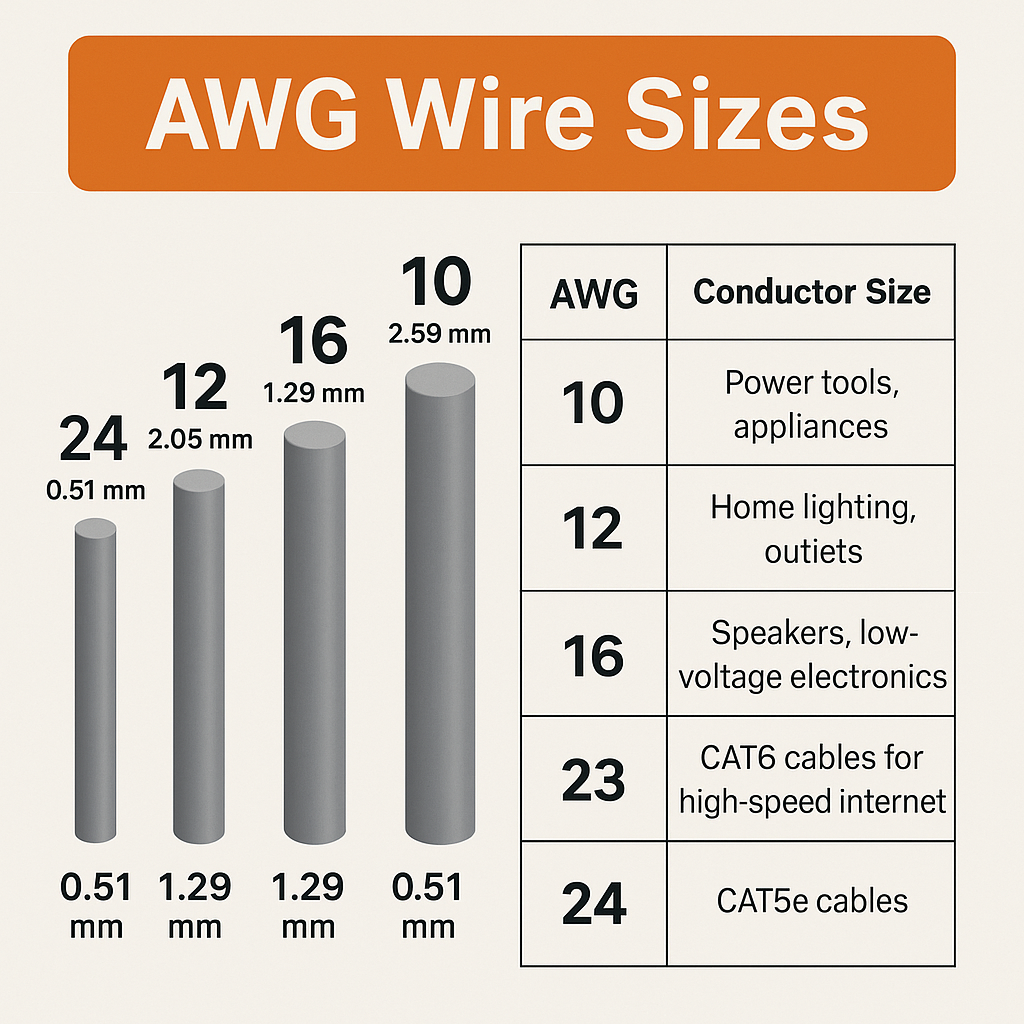📏 Understanding AWG: A Complete Guide to Wire Gauge Measurement
AWG (American Wire Gauge) is the standard method used in North America to measure the diameter of electrically conducting wires. Whether you're working with copper or aluminum cables, knowing how to read the AWG system is essential for selecting the right cable for electrical performance, safety, and efficiency.
🔍 What is AWG?
AWG, short for American Wire Gauge, is a standardized wire gauge system used since 1857 for non-ferrous conductors (mainly copper and aluminum). It determines the wire diameter and indirectly its current-carrying capacity (ampacity), resistance, and weight.
📐 AWG to Millimeter Conversion Table
Here’s a quick reference table showing some common AWG sizes and their diameters in millimeters (mm):
| AWG Size | Diameter (mm) | Diameter (inches) |
|---|---|---|
| 4/0 | 11.684 | 0.4600 |
| 3/0 | 10.404 | 0.4096 |
| 2/0 | 9.266 | 0.3648 |
| 1/0 | 8.251 | 0.3249 |
| 1 | 7.348 | 0.2893 |
| 2 | 6.544 | 0.2576 |
| 4 | 5.189 | 0.2043 |
| 6 | 4.115 | 0.1620 |
| 8 | 3.264 | 0.1285 |
| 10 | 2.588 | 0.1019 |
| 12 | 2.053 | 0.0808 |
| 14 | 1.628 | 0.0641 |
| 16 | 1.291 | 0.0508 |
| 18 | 1.024 | 0.0403 |
| 20 | 0.812 | 0.0320 |
| 22 | 0.644 | 0.0253 |
| 24 | 0.511 | 0.0201 |
| 26 | 0.405 | 0.0159 |
| 28 | 0.321 | 0.0126 |
| 30 | 0.255 | 0.0100 |
✅ Important Note: The **larger the AWG number, the smaller the diameter of the wire.
📊 Visual Explanation of AWG
Below is a simplified illustration to help you visualize the thickness difference between various AWG sizes:

Image Source: Wikimedia Commons
💡 Examples of Usage
Let’s look at a few real-life applications:
🔌 CAT6 Ethernet Cable
-
Typically uses 23 AWG
-
Conductor diameter: ~0.573 mm
-
Ideal for high-speed LAN networks (1 Gbps or higher)
🔌 CAT5e Ethernet Cable
-
Typically uses 24 AWG
-
Conductor diameter: ~0.511 mm
-
Standard for general networking up to 100 Mbps
🔋 Speaker Wires
-
16 AWG is commonly used for speaker wire in home theater setups
-
Diameter: ~1.291 mm
-
Offers good balance between flexibility and power capacity
🔋 Automotive Wire
-
12 AWG is often used for car battery connections or heavy-duty automotive use
-
Diameter: ~2.05 mm
-
Can handle more current and heat without performance loss
🧠 Why AWG Matters
-
Current Capacity: Thicker wires (lower AWG) can carry more current.
-
Resistance: Higher AWG means thinner wire and higher resistance, which may lead to voltage drop.
-
Safety: Undersized wires may overheat and pose a fire risk.
-
Cost: Thicker cables cost more but are crucial for long runs and power-heavy devices.
⚠️ Final Tips for Choosing the Right AWG
-
✅ Always match AWG with current load and distance
-
✅ Use lower AWG (thicker wire) for high-current devices like AC units or EV chargers
-
✅ For data transmission, use the recommended AWG (e.g., 23AWG for CAT6)
📌 Summary
| AWG | Conductor Size | Common Use |
|---|---|---|
| 10 | 2.59 mm | Power tools, appliances |
| 12 | 2.05 mm | Home lighting, outlets |
| 16 | 1.29 mm | Speakers, low-voltage electronics |
| 23 | 0.57 mm | CAT6 cables for high-speed internet |
| 24 | 0.51 mm | CAT5e cables |
If you're dealing with electrical installation, audio setups, or networking, understanding AWG is essential for safety, efficiency, and performance. Make sure to refer to manufacturer specifications and follow local electrical codes.

